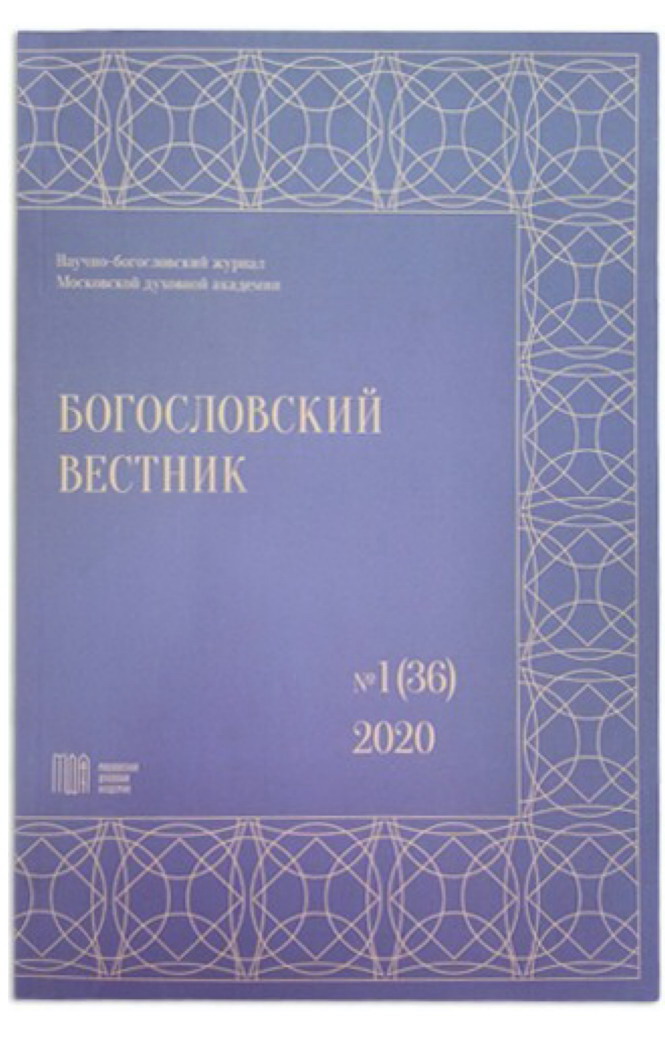A Zion Theology in First Part of Zechariah’s Book in the Context and out of the Context of the Reconstruction of Jerusalem Temple
DOI:
https://doi.org/10.31802/2500-1450-2020-36-1-42-762Keywords:
Bible, the book of Zechariah, theology of Old Testament, Zion theology, daughter of Zion, presence of God, house of God, Old Testament worship, the Second Temple, post-exilic Judean communityAbstract
This article discusses the concept of Zion, one of the biblical toponyms widely used as a theological concept in the Old Testament prophetic books, psalms, the New Testament primarily to denote Divine presence. However, the subject of this study is the specific features of the theology of Zion, which are expressed in 1-8 chapters of the book of Zechariah. Research interest for this part of Scripture is due to the fact that it is dated by the initial stage of the restoration of the temple in Jerusalem. The Bible distinguishes three aspects of the understanding of the Divine presence in Zion, the presence of a temple and worship, the presence of a monarch from the davidic dynasty and peace and justice among the people of God. It raises the question of what aspect Zechariah gave priority to his understanding of the presence of the Lord in Zion. To solve the problem, the author turns to the analysis of the intertextual links of the considered passages of the book of the Prophet Zechariah with the prophetic and priestly tradition evidenced in the Old Testament, with ancient parallels. These methods are applied taking into account the specific historical situation of the creation of the studied texts. As a result of the research, the prophet Zechariah’s conception of Zion reveals a combination of liturgical and social (communal) understanding of the presence of the Lord.
Downloads
References
ИСТОЧНИКИ
Вiblia Hebraica Stuttgartensia / ed. R. Kittel; 5 ed. Stuttgart: Deutsche Bibelgesellschaft, 1997.
Cyrillus Alexandrinus. Commentariorum in XII prophetas minores. In Zachariam prophetam // PL. T. 72. Col. 9–275.
Hieronymus Stridonensis. Commentariorum in Zachariam prophetam // PL. T. 24. Col. 1415– 1542.
Septuaginta, Id est Vetus Testamentumgraeceiuxta LXX interpretes / ed. A. Rahlfs. Stuttgart: Deutsche Bibelgesellschaft, 1979.
Иероним Стридонский, блж. Творения. Киев: тип. И. И. Горбунова, 1900. т. 15.
Кирилл Александрийский, свт. толкование на пророка Захарию / пер. П. И. Казанского; под ред. М. Д. Муретова // БВ. 1897. т. 1. № 1. с. 1–16; т. 1. № 2. с. 17–32; т. 1. № 3. с. 33–48; т. 2. № 4. с. 49–64; т. 2. № 6. с. 65–80; т. 3. № 8. с. 81–96; 1898. т. 1. № 1. с. 97–112; т. 1. № 2. с. 113–128; т. 1. № 3. с. 129–144; т. 2. № 4. с. 145–160; т. 2. № 5. с. 161–176; т. 2. № 6. с. 177–192; т. 3. № 7. с. 193–224; т. 3. № 8. с. 225–232. (1 пагинация).
ЛИТЕРАТУРА
Айзенштадт Ш. Пророки, их эпоха и социальное учение. М.: Параллели, 2004.
Бельский В. В. Социальное учение пророка Захарии (Зах 7:9–10) в отношении к «пророческому движению» в Палестине (первая половина I тыс. до н. э.) // Вестник Хакасского государственного университета им. Н. Ф. Катанова. 2016. № 17. с. 78– 81.
Введение в Ветхий Завет / под ред. Э. Ценгера. М.: ББИ, 2008.
Образцов П., свящ. опыт толкования св. пророка Захарии в порядке последовательного чтения священного писания. спб.: тип. Деп. уделов, 1873.
Палладий (Пьянков), еп. Толкование на книгу святого пророка Захарии. Вятка: тип. Куклина, 1876.
Рождественский Д., свящ. Книга пророка Захарии: исагогическое исследование. Сергиев Посад: СТСЛ, 1910. Вып. I: Введение. Писатель и его время. Анализ содержания книги.
Alonso Schökel L., Sicre Diaz J. L. Profetas. Madrid: Ediciones Cristiandad, 1980. T. 2.
Barthtelemy D. Critique textuelle de l’ Ancien Testament. Ezechiel, Daniel et les 12 Prophetes. Fribourg; Göttingen: Editions Universitaires; Vandenhoeck und Ruprecht, 1992. T. 3.
Follis E. R. The Holy City as Daughter // Directions in the Biblical Hebrew Poetry / ed. by E. R. Follis. Sheffield: Sheffield University Press, 1987. P. 173–184.
Hallaschka M. Haggai und Sacharja 1–8, Eine Redaktionsgeschichtliche Untersuchung. Berlin: Walter de Gruyter, 2010.
Halpern B. The Ritual Background of Zechariah’s Temple Song // The Catholic Biblical Quartely. 1977. Vol. 40. № 2. P. 167–190.
Helyer L. R. Mountaintop Theology, Panoramic Perspectives of Redemptive History. Eugen: Cascade Books, 2016.
Lux R. Prophetie und Zweiter Tempel, Studien zu Haggai und Sacharja. Tübingen: Mohr Siebeck, 2009.
Marinkovic P. What does Zechariah 1–8 Tell us About the Second Temple? // Second Temple Studies / ed. by T. C. Eskenazi and K. H. Richards. Sheffield: JSOT Press, 1991. Vol. 2: Temple and Community in the Persian Period. P. 88–103.
Mason R. Preaching the Tradition, Homily and Hermeneutics After the Exile. Cambridge: Cambridge University Press, 1990.
Mohr J.O. Israel als Licht der Welt? Heilsuniversalismus im Buch Sacharja. Hamburg: Diplomica Verlag, 2013.
Moor J. C., de. Micah 1. A Structural Approach // The Structural Analysis of Biblical and Canaanite Poetry / ed. by W. van der Meer & J. C. Moor. Sheffield: JOST Press, 1988. P. 172–185.
Otto E. ןוֹיּצִ ṣijjôn // Theologisches Wörterbuch zum Alten Testament / in Verbindung mit G. W. Anderson, H. Cazelles, D. N. Freedman, Sh. Talmon u. G. Wallis; begr. von G. J. Botterweck u. H. Ringgren; hrsg. H.J. Fabri u. H. Ringgren, in X Bb. B. VI. Stuttgart; Berlin; Köln: Kohlhammer Verlag, 1989. S. 994–1027.
Schmitt H.Chr. Theologie in Prophetie und Pentateuch, Gesammelte Schriften / hrsg. von Ulrike Schorn und Matthias Büttner. Berlin; New York: Walter de Gruyter, 2001. (Beihefte zur Zeitschrift für die alttestamentliche Wissenschaft; Bd. 310).
Seybold Kl. Die Bildmotive in den Visionen des Propheten Sacharja // Studies on Prophecy, A Collection of Twelve Papers. Leiden: Brill, 1974. P. 92–110.
Stead M. R. The Intertextuality of Zechariah 1–8. New York: T&T Clark International, 2009.
The BrownDriverBriggs Hebrew and English Lexicon: with an Appendix Containing the Biblical Aramaic / by F. Brown, with the Cooperation of S. R. Driver and Ch. A. Briggs. Peabody (MA): Hendrickson, 2000.








